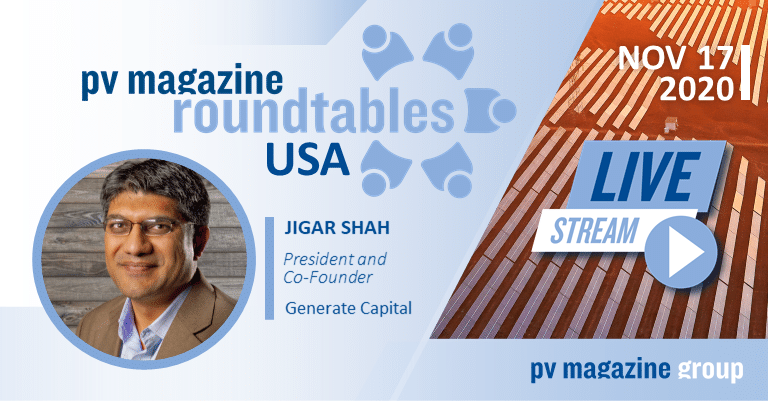“Once you get to a certain level of maturity of a technology, the only way to really achieve cost reduction is through deployment of that technology, and the more deployment that you put out there, the more micro innovations are allowed to come into the space,” Jigar Shah, the co-founder of Generate Capital said during a discussion on deployment-led innovation for sustainable infrastructure hosted by the Institute of Electrical and Electronics Engineers (IEEE) Santa Clara Valley Sustainability Chapter.
Although deployment-led innovation is often aided by rebates and tax incentives that can pull down costs, these incentives can also outlive their usefulness.
“Solar and wind technologies are basically crowding out other technologies [because of the tax incentives they receive]… We are not going to decarbonize our entire economy without at least 50 to 100 technologies – not just two,” Shah said.
“We’ve averaged 2.4 cents a kilowatt hour for the last six months for PPAs. That’s actually too low. I think we would be fine at 3.4 cents… I don’t think that solar and wind industries would skip a beat [without their tax incentives], and they have other policy mechanisms,” Shah said.
Other technologies
In the power sector, there are lots of other innovative technologies – like anaerobic digesters, small-scale hydro, fuel cells, geothermal technologies and battery storage demand response load control technologies – just sitting on the shelf. Hydrogen, which is already a roughly $130 billion business globally, also doesn’t need much in the way of innovation at its most fundamental industry level, Shah said, pointing out that hydrogen is growing 4% or 5% a year.
Because hydrogen is used in the making of chemicals and fertilizer and in the processing of oil and gas, excess electricity that is turned into hydrogen can be shifted and sold into these other markets. For renewable developers, this can be helpful during a protracted low price cycle, and for industrial companies that are heavy emitters, this could help them transition to a low-carbon economy. Hydrogen’s exhaust is water.
Want to hear more from Jigar?

Policy and follow-through matter
Right now, about half of the U.S. transmission system is used less than 30% of the time because the system was built out to be able to handle the greatest possible demand, not daily load. “We are spending $37 billion dollars a year now on building out new transmission and new distribution. Only about $14 billion of that is transmission; the rest is distribution,” Shah said.
“It [would be] cheaper to pay people to have flexible load that is controlled by a third party than it [would be] to build out more distribution lines… We just need to reform our grid into a whole new set of rules,” he said.
Similarly, on the solar panel and battery recycling side, an extended producer responsibility approach – which makes the manufacturers of future waste responsible for disposal on behalf of their customers – could help. “It’s far more cost effective for manufacturers to be forced to work together, to own recycling facilities in a joint fashion, where they try to greatly reduce the cost of all that collectively. That happens through policy. It doesn’t happen through people opting in,” Shah said.
“All of us [need] to recognize that politics is one thing, but policy is critical to all the systems that we interact with,” Shah said.
“The U.S. government procures $4 billion of electricity per year. They could actually sign a contract for probably 50,000 megawatts of PPAs for renewable energy using existing contracting. It would probably take three years of red tape to get it done, but I think it’s worth doing,” he said, explaining that a corporate PPA that the federal government can use for this has been around since 2007.
Follow through is also important. The Obama Administration said that the U.S. should buy all electric vehicles for its fleet, but not a single one was purchased, Shah added.
This content is protected by copyright and may not be reused. If you want to cooperate with us and would like to reuse some of our content, please contact: editors@pv-magazine.com.








Autonomous 24/7/365 generators are the missing ingredient for rapid replacement of fossil fuels. The first one was demonstrated 100 years ago by Alfred Hubbard. It powered a 35hp electric boat. Now, a century later, a modern version is in development and has several parallel technologies. 24/7 action to complete development and launch world wide implementation can help humanity maintain a livable planet. This can be called TIGER – The Inexpensive Green Energy Revolution.
Good stuff Jigar. I recently read a note from Jenny Chase talking about how grid connections were gold dust. Jenny is rarely off the mark but when I read this I thought about how you often mention the low utilization of some of our transmission lines. While there are certainly local areas of congestion (mostly around mega-cities like LA and the NYC to DC corridor) it’s not a pervasive problem by any stretch. As you’ve mentioned, we should be looking for way to optimize the existing lines. How could we do this? It’s pretty obvious. Price signals! What is taking our policy makers so long to restructure our electric rates? What are people afraid of? Keep it voluntary to start with. I’d happily tell my EV to charge on off peak electricity. Let’s get on with it already.